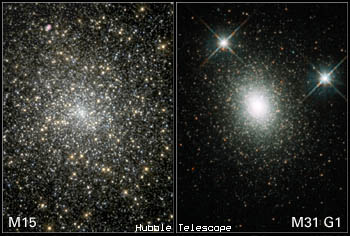
Black Holes
When a star runs out of fuel, one of three things happens. If the star is large, it usually explodes and its gasses are spread across the universe. If the star is small, it collapses into a brown dwarf, where it begins fusion again, but on a much smaller scale. These stars burn very faintly and are hard to detect. The third possibility occurs when a star's mass is smaller than the star needs to explode, but larger than the mass needed to form a brown dwarf. In this case, the star collapses in on itself until all its mass is located at a single point of infinite density (a singularity). This infinitesimally small star cannot be seen, for even light cannot escape its gravitational pull. Everything within a certain radius (the event horizon) of a black hole is sucked in and from the point it crosses the event horizon we know nothing of what happens to it. Normal laws of physics (relativity and Newtonian mechanics) break down at singularities, but the gravitational force of the black hole's mass can still be felt by surrounding objects.
Black holes are intriguing ideas, but they are not likely to account for much dark matter. This is because most stars the size needed to make a black hole are not likely to have already run out of fuel since the big bang. However, we have seen evidence that they exist in the lensing effect of their gravity on the light from stars behind the black hole. Physicists are very certain that a black hole exists in each of the two galaxies below. We can predict black holes to exist in the universe, but their combined mass does not come close to accounting for dark matter.
